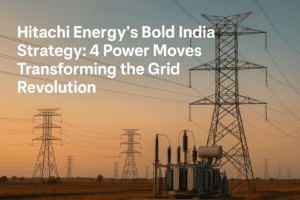Hitachi Energy’s Bold India Strategy: 4 Power Moves Transforming the Grid Revolution
India’s massive renewable energy push demands robust grid infrastructure, and Hitachi Energy is strategically positioning itself as a key enabler. The company rejects technology silos, instead integrating High Voltage Direct Current (HVDC) transmission – crucial for moving power over vast distances like its Bhadla-Fatehpur project – with Battery Energy Storage Systems (BESS) to stabilize volatile renewable output, endorsing India’s mandate for co-located storage. Backing this vision, Hitachi is investing heavily, averaging ₹100 crore annually and recently raising ₹2,520 crore to expand capacity, particularly for HVDC and digital grid tools.
Recognizing the critical need for reliability, a new Service Business Unit targets India’s massive ₹82,000 crore installed base for maintenance and upgrades. Beyond utilities, data centers represent a significant growth area (15% of industrial revenue), requiring ultra-stable power. Critically, solar-plus-storage is now cheaper than coal in key states like Rajasthan and Gujarat, accelerating the transition. Through its Chennai factory and holistic approach, Hitachi focuses on building the essential, unglamorous grid resilience needed to turn India’s clean energy ambitions into secure, affordable reality.

Hitachi Energy’s Bold India Strategy: 4 Power Moves Transforming the Grid Revolution
India’s energy landscape isn’t just growing – it’s undergoing radical surgery. As renewable capacity explodes and grids groan under new demands, Hitachi Energy’s India CEO N Venu reveals how the company is building the nervous system for this transformation. Here’s what matters beyond the corporate speak:
- The “Multi-Tech Mandate” Replacing Silver Bullets
Venu’s insight: “No single technology can solve India’s energy trilemma.”
While rivals push either batteries or transmission, Hitachi bets on synergy:
- HVDC as the backbone: Securing projects like Bhadla-Fatehpur (1,500km+) proves its role in moving desert solar across states.
- Storage as the stabilizer: Endorsing India’s mandate for 10% solar co-located storage to manage renewable volatility.
- The hidden advantage: Their Chennai factory (opened 2023) now builds both – avoiding tech turf wars.
- The 100-Crore Confidence Vote
Amid foreign firms hesitating on India investments, Hitachi’s annual ₹100cr+ commitment signals rare conviction. Their recent ₹2,520cr institutional raise funds three critical gaps:
- Scaling HVDC production for mega-projects
- Building service teams for renewable integration
- Digital grid management tools
Why it matters: This counters “capital flight” narratives in heavy engineering.
- The Service Shift You Missed
Their new Service Business Unit (live since April 2025) targets India’s ₹82,000cr hidden opportunity: maintaining existing grid infrastructure. This isn’t just repairs – it’s about:
- Preventing renewable downtime (critical for 30GW/year additions)
- Retrofitting old grids for solar/wind compatibility
- Training 5,000+ technicians for the energy transition
- Data Centers: The Silent Grid Disruptor
Beyond utilities, Venu highlights data centers as unexpected grid stressors. Hitachi’s move here reveals:
- Bangalore/Mumbai hyperscalers need millisecond-level power stability
- Renewable-powered DCs require specialized transformers (a Hitachi niche)
- 15% of their industrial revenue now comes from this sector
The Real Story Beneath the Headlines
India’s net-zero push hinges less on generating clean energy (we’re doing that) than on moving and managing it. Hitachi’s playbook – balancing transmission (HVDC), stability (storage), and service – offers a template for how infrastructure giants must operate in the volatility era.
As Venu notes: “The transition is no longer about sustainability alone. Security and affordability now share the throne.” For industries and households, that means grids that won’t collapse when the sun sets or winds stall – the unglamorous foundation of India’s energy ambitions.
Data point to watch: Their claim that solar-plus-storage is now cheaper than coal lifecycle costs in Rajasthan/Gujarat. If validated, it could accelerate India’s coal sunset.
You must be logged in to post a comment.